Telstra Bundle
How Well Do You Know the History of Telstra?
From its humble beginnings as a government department, Telstra has become a titan of the Australian telecommunications landscape. This journey showcases a remarkable transformation, marked by strategic pivots and technological leaps. Explore the Telstra SWOT Analysis to understand its current position.
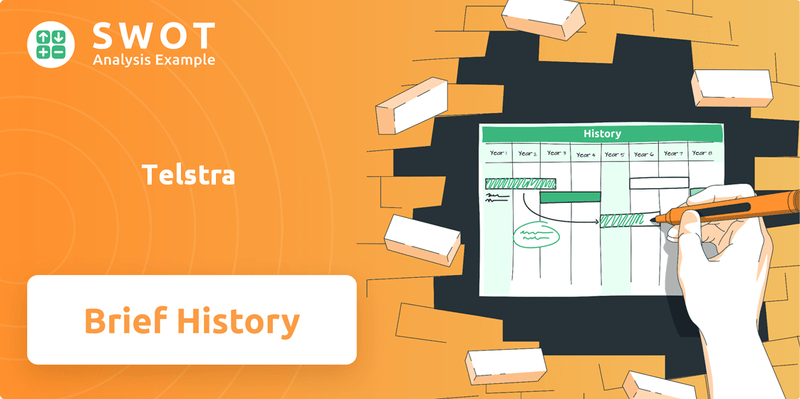
The story of Telstra, a pivotal player in Australian telecommunications, is a compelling narrative of growth and adaptation. Tracing the Telstra history reveals how the company, originally established in 1901, has evolved through significant milestones, including privatization and technological advancements. Understanding the Telstra company's evolution is key to appreciating its current dominance in the Australian market and its impact on connecting remote regions.
What is the Telstra Founding Story?
The story of the Telstra company is a journey through the evolution of Australian telecommunications. It began with government initiatives and transformed into a publicly traded entity. This transformation reflects Australia's broader economic shifts.
Understanding the Telstra history requires looking back to its roots. The initial framework was established by government bodies, setting the stage for the modern telecommunications giant.
The evolution of Telstra Australia showcases the growth of the telecommunications sector. From its inception, the company has adapted to technological advancements and market changes.
The genesis of Telstra can be traced back to 1901, with the creation of the Postmaster-General's Department (PMG) by the Australian government. Initially, the PMG managed domestic telephone, telegraph, and postal services.
- In 1946, the Overseas Telecommunications Commission (OTC) was established to handle Australia's international telecommunications.
- In July 1975, the Australian Telecommunications Commission (ATC), known as Telecom Australia, was formed, taking over the telecommunications operations from the PMG.
- In February 1992, the OTC merged with Telecom Australia to form the Australian and Overseas Telecommunications Corporation (AOTC).
- On July 1, 1992, AOTC was rebranded as Telstra, becoming a public company listed on the Australian Stock Exchange. The name 'Telstra' is derived from 'Telecommunication Australia.'
- The privatization process concluded by 2006.
Telstra SWOT Analysis
- Complete SWOT Breakdown
- Fully Customizable
- Editable in Excel & Word
- Professional Formatting
- Investor-Ready Format
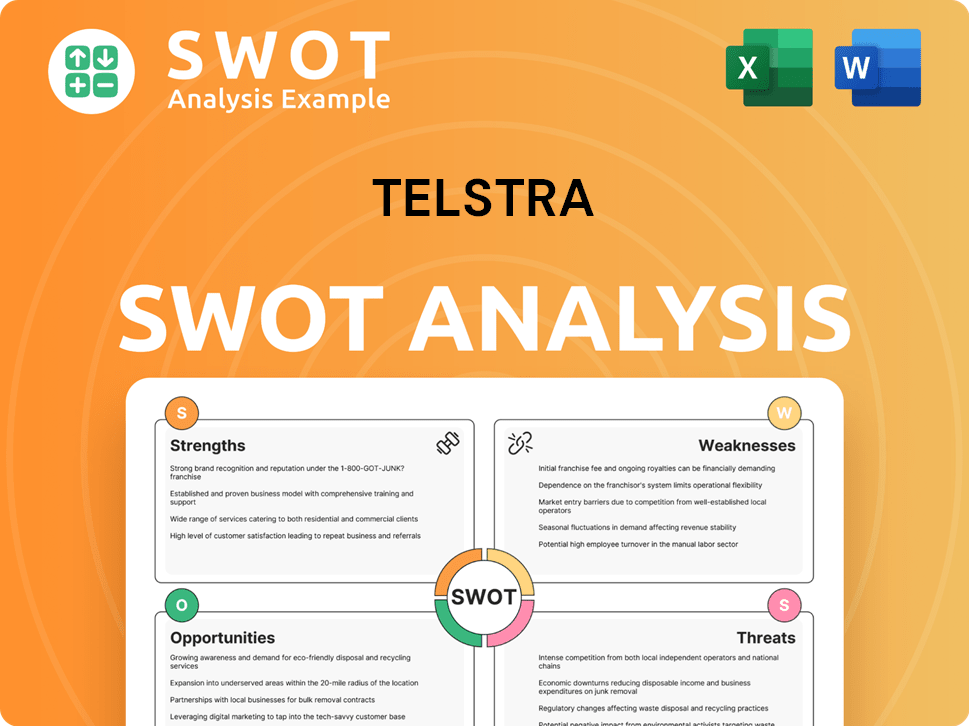
What Drove the Early Growth of Telstra?
The early growth of the Telstra company, then known as Telecom Australia, marked a pivotal period in Australian telecommunications. This period saw the company pioneering mobile telephony services, setting the stage for future advancements. The evolution of Telstra Australia reflects its commitment to technological innovation and expansion across the country.
In 1981, Telecom Australia introduced automated mobile services in major cities, offering 'car phone' capabilities. This was a significant step, as portable handheld devices were not yet common. By 1987, the company launched Australia's first cellular system using the AMPS analogue standard, enabling the use of portable handheld phones.
The late 1990s saw the addition of 1800 MHz capacity channels to the GSM network, alongside GPRS packet data transmission. In 2006, the GSM network was upgraded to full EDGE data transmission, increasing speeds. Telstra consistently invested in new technologies, including 5G, to enhance its network infrastructure.
Telstra expanded its services to include a wide range of digital solutions, such as cloud services and cybersecurity. As of June 30, 2024, Telstra provides roughly 24.2 million retail mobile services across Australia. The company has a global presence, operating in over 30 countries with access to over 2,000 network points of presence in more than 200 countries and territories.
Telstra offers a variety of services, including mobile, data, and voice options. Approximately 3.6 million consumer and small business customers use bundled, data, and voice-only services. This diverse range of services showcases Telstra's ability to meet the evolving needs of customers in the digital age and its continued growth.
Telstra PESTLE Analysis
- Covers All 6 PESTLE Categories
- No Research Needed – Save Hours of Work
- Built by Experts, Trusted by Consultants
- Instant Download, Ready to Use
- 100% Editable, Fully Customizable
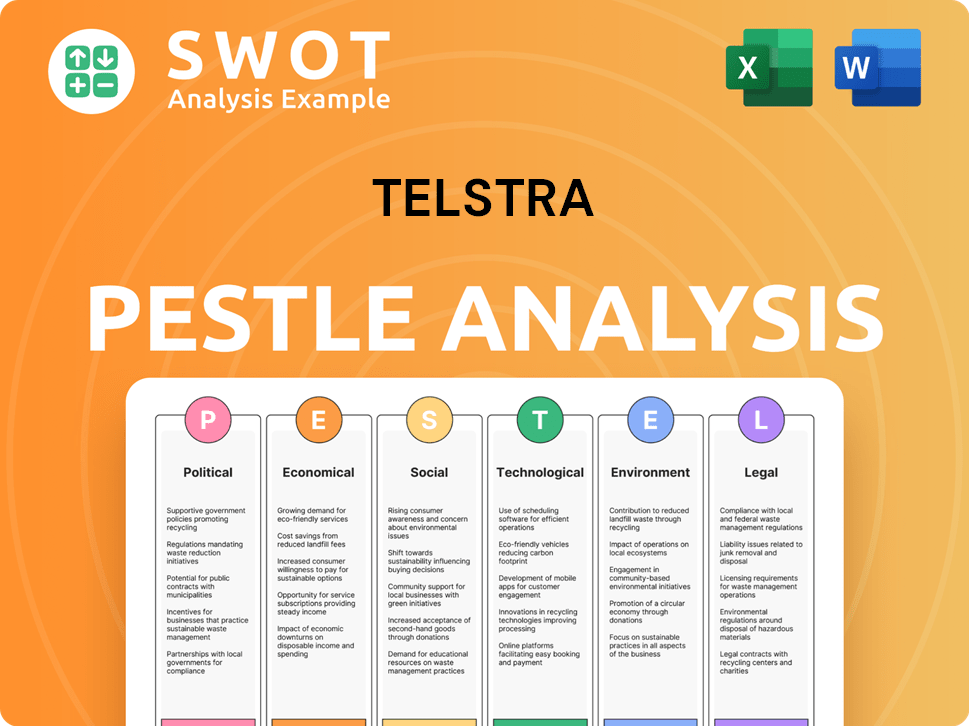
What are the key Milestones in Telstra history?
The Telstra company has a rich Telstra history marked by significant milestones in Australian telecommunications. From its early days as a government-owned entity to its current status as a leading telecommunications provider, the company has consistently adapted and evolved. This Telstra timeline reflects its journey through technological advancements and market changes.
| Year | Milestone |
|---|---|
| 1981 | Launched the first automated mobile services in Australia. |
| 1987 | Introduced the first cellular system for handheld phones. |
| Late 1990s | Introduced 1800 MHz capacity channels and GPRS. |
| 2006 | Upgraded to EDGE data transmission. |
| August 2024 | Achieved 89% 5G population coverage in Australia, with 54% of its mobile traffic on 5G. |
| January 2025 | Announced a proposed joint venture with Accenture to accelerate its data and AI roadmap. |
Telstra's evolution is characterized by continuous innovation. The company has consistently invested in network upgrades and embraced new technologies to enhance its services. These advancements have played a crucial role in shaping the telecommunications landscape in Australia.
Telstra was an early developer of mobile telephony in Australia, launching the first automated mobile services in 1981.
In 1987, Telstra launched the first cellular system for handheld phones, marking a significant step in mobile communications.
Telstra consistently invested in network upgrades, including the introduction of 1800 MHz capacity channels and GPRS in the late 1990s.
In 2006, Telstra upgraded to EDGE data transmission, improving data speeds for its customers.
As of August 2024, Telstra has achieved 89% 5G population coverage in Australia, with 54% of its mobile traffic on 5G.
In January 2025, Telstra and Accenture announced a proposed joint venture to accelerate Telstra's data and AI roadmap.
Despite its successes, Telstra Australia has faced several challenges. The company operates in a highly competitive market, and it has had to manage costs effectively. These challenges have required strategic adjustments and a focus on efficiency.
Telstra operates in a competitive market, facing competition from other major players like Optus.
Telstra has focused on cost management, aiming for a $350 million net fixed cost reduction target by FY25.
In May 2024, Telstra announced organizational changes and actions on cost, which contributed to a decrease in operating expenses.
Despite challenges, Telstra reported a Net Profit after Tax of $1.1 billion in the first half of FY25, up 7.1%.
Earnings Per Share were 8.9 cents, up 6% in the first half of FY25.
The company's underlying Return on Invested Capital (ROIC) was 8.3% in FY24, with a target to reach 10% by FY30. For more information, read the Growth Strategy of Telstra.
Telstra Business Model Canvas
- Complete 9-Block Business Model Canvas
- Effortlessly Communicate Your Business Strategy
- Investor-Ready BMC Format
- 100% Editable and Customizable
- Clear and Structured Layout
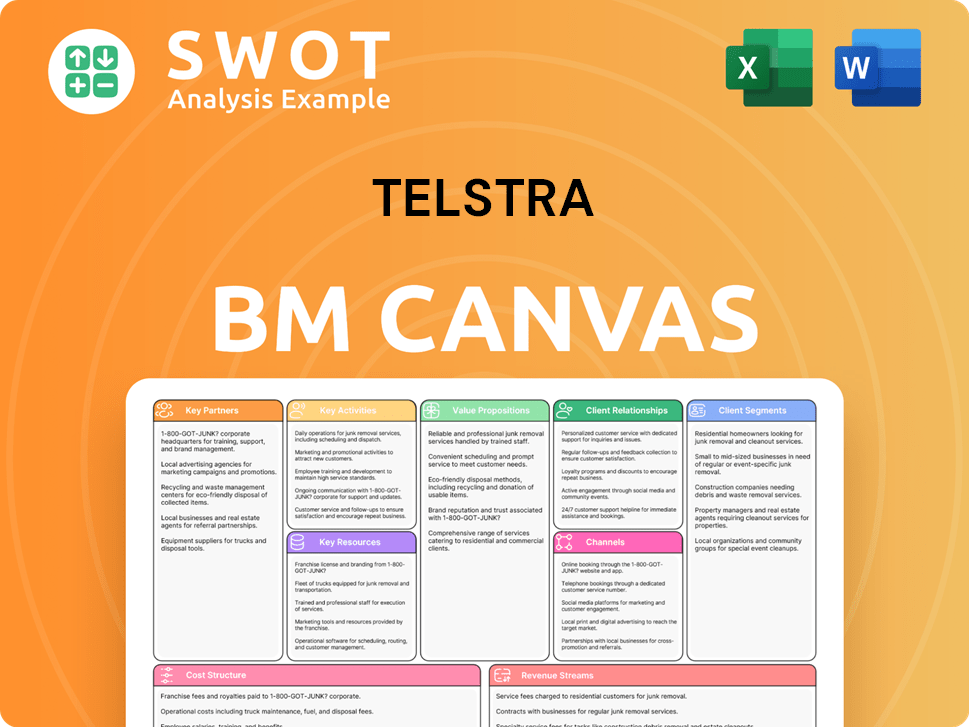
What is the Timeline of Key Events for Telstra?
The Telstra company, a key player in Australian telecommunications, has a rich history. Its journey began with government initiatives and evolved through privatization and technological advancements. This Telstra history showcases its adaptation to the changing telecommunications landscape.
| Year | Key Event |
|---|---|
| 1901 | Postmaster-General's Department (PMG) was established, which laid the foundation for telecommunications in Australia. |
| 1946 | Overseas Telecommunications Commission (OTC) was established to manage international telecommunications. |
| 1975 | Australian Telecommunications Commission (ATC), trading as Telecom Australia, was created. |
| 1981 | First company to provide mobile telephony services in Australia. |
| 1992 (February) | OTC merged with Telecom Australia to form Australian and Overseas Telecommunications Corporation (AOTC). |
| 1992 (July 1) | AOTC rebranded as Telstra, listed on the Australian Stock Exchange. |
| 1995 (July 1) | Domestic trading name 'Telecom Australia' changed to Telstra. |
| 2006 | Telstra fully privatized. |
| 2024 (August 12) | Telstra released its FY24 Annual Report, reporting 89% 5G population coverage. |
| 2024 (December 20) - 2025 (January 7) | Telstra Fibre Embargo period. |
| 2025 (January) | Telstra International unveiled vision for its network of the future, focusing on upgrading subsea cable infrastructure to over 800 Tbps. |
| 2025 (February 20) | Telstra announced its FY25 half-year results, reporting a 7.1% increase in Net Profit after Tax to $1.1 billion. |
| 2025 (February 25) | Telstra and Accenture finalized details of a proposed joint venture to accelerate Telstra's data and AI roadmap. |
| 2025 (May 22) | Telstra announced price increases for most postpaid mobile and internet plans from July 1, 2025, to fund an $800 million network upgrade. |
| 2025 (May 27) | Telstra unveiled its 'Connected Future 30' strategy, aiming for mid-single-digit compound annual growth in cash earnings to FY30 and an underlying ROIC of 10% by FY30. |
Telstra's 'Connected Future 30' strategy focuses on growth and efficiency. The company is targeting mid-single-digit compound annual growth in cash earnings through FY30. This strategy leverages Telstra's leadership in mobiles and digital infrastructure.
Telstra is investing heavily in its network. This includes expanding its 5G technology and intercity fibre, such as the Sydney-Canberra coastal route, scheduled to go live in June 2025. The company plans to treat its network as a product.
Telstra International is upgrading its subsea cable infrastructure. This upgrade is in response to increasing bandwidth demands driven by cloud and AI applications. The goal is to meet the growing needs of global connectivity.
The company is committed to innovation, developing global R&D capabilities in areas like 5G, AI, and cybersecurity. Telstra's strategic focus is to be the number one choice for connectivity in Australia, aligning with its founding vision.
Telstra Porter's Five Forces Analysis
- Covers All 5 Competitive Forces in Detail
- Structured for Consultants, Students, and Founders
- 100% Editable in Microsoft Word & Excel
- Instant Digital Download – Use Immediately
- Compatible with Mac & PC – Fully Unlocked
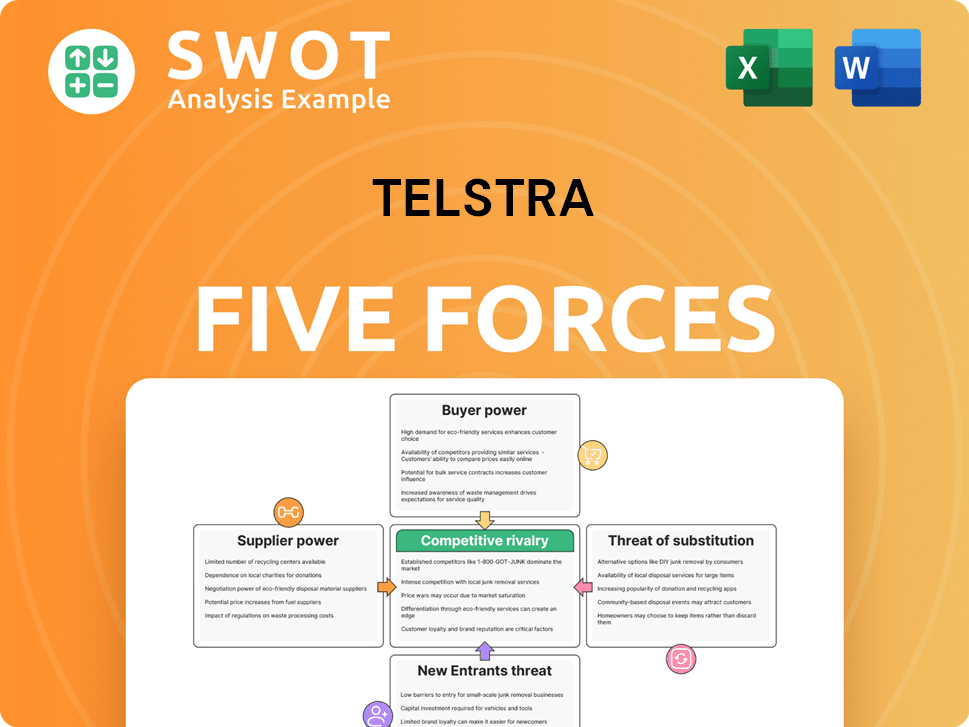
Related Blogs
- What is Competitive Landscape of Telstra Company?
- What is Growth Strategy and Future Prospects of Telstra Company?
- How Does Telstra Company Work?
- What is Sales and Marketing Strategy of Telstra Company?
- What is Brief History of Telstra Company?
- Who Owns Telstra Company?
- What is Customer Demographics and Target Market of Telstra Company?
Disclaimer
All information, articles, and product details provided on this website are for general informational and educational purposes only. We do not claim any ownership over, nor do we intend to infringe upon, any trademarks, copyrights, logos, brand names, or other intellectual property mentioned or depicted on this site. Such intellectual property remains the property of its respective owners, and any references here are made solely for identification or informational purposes, without implying any affiliation, endorsement, or partnership.
We make no representations or warranties, express or implied, regarding the accuracy, completeness, or suitability of any content or products presented. Nothing on this website should be construed as legal, tax, investment, financial, medical, or other professional advice. In addition, no part of this site—including articles or product references—constitutes a solicitation, recommendation, endorsement, advertisement, or offer to buy or sell any securities, franchises, or other financial instruments, particularly in jurisdictions where such activity would be unlawful.
All content is of a general nature and may not address the specific circumstances of any individual or entity. It is not a substitute for professional advice or services. Any actions you take based on the information provided here are strictly at your own risk. You accept full responsibility for any decisions or outcomes arising from your use of this website and agree to release us from any liability in connection with your use of, or reliance upon, the content or products found herein.